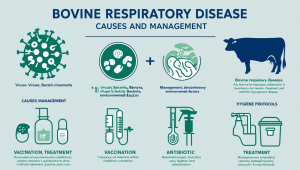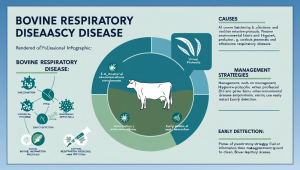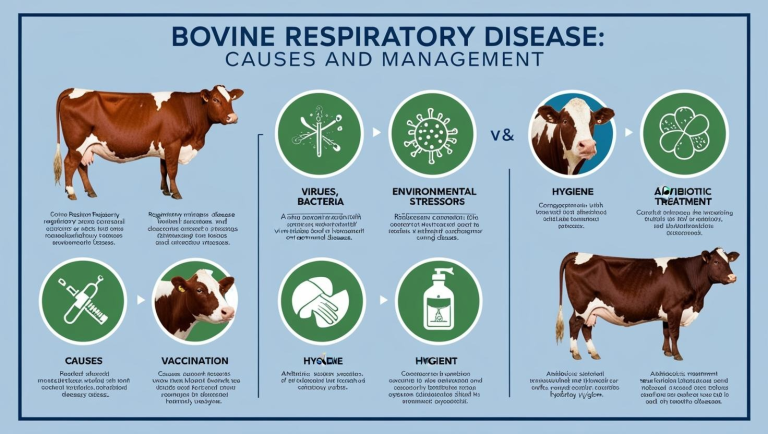Bovine Respiratory Disease (BRD), often referred to as “shipping fever,” is one of the most economically significant diseases in cattle farming. It affects the respiratory system, leading to poor weight gain, increased mortality, and reduced feed efficiency. BRD is a multifactorial disease influenced by infectious agents, environmental stressors, and management practices.
This article provides a comprehensive overview of BRD, including its causes, symptoms, risk factors, diagnosis, treatment, and prevention strategies to help cattle farmers manage this disease effectively.
Click HERE to join our WhatsApp group
Understanding Bovine Respiratory Disease (BRD)
a. What is BRD?
BRD is a complex respiratory disease affecting the lungs and airways of cattle. It commonly occurs in feedlot cattle, calves, and newly transported animals. The disease results from a combination of viral and bacterial infections, stress, and poor management.
b. Economic Impact of BRD
Decreased growth rates – Sick cattle eat less and gain weight slowly.
Increased treatment costs – Antibiotics, veterinary services, and labor costs.
Higher mortality rates – BRD can cause severe lung damage, leading to death.
Reduced meat quality – Chronic infections lead to lung abscesses, reducing carcass value.
READ ALSO: TIPS TO PREVENT THEFT ON FARM
Causes of Bovine Respiratory Disease

a. Infectious Agents
BRD is caused by a combination of viruses and bacteria that weaken the immune system and allow secondary infections to develop.
1. Viral Causes (Primary Infection)
Viruses damage the respiratory tract, making cattle vulnerable to bacterial infections.
Bovine Herpesvirus-1 (BHV-1) – Causes Infectious Bovine Rhinotracheitis (IBR).
Bovine Viral Diarrhea Virus (BVDV) – Suppresses immunity, increasing BRD risk.
Bovine Respiratory Syncytial Virus (BRSV) – Damages lung tissue.
Parainfluenza-3 Virus (PI3) – Mild infection but predisposes to bacterial pneumonia.
2. Bacterial Causes (Secondary Infection)
Mannheimia haemolytica – Produces toxins that destroy lung cells.
Pasteurella multocida – Causes chronic pneumonia and lung damage.
Histophilus somni – Causes respiratory and nervous system disease.
Mycoplasma bovis – Leads to chronic pneumonia and joint infections.
b. Environmental and Management Factors
Transportation Stress (Shipping Fever): Long-distance transport, overcrowding, and dehydration suppress immunity.
Sudden Diet Changes: High-grain diets can alter gut bacteria, affecting immune function.
Weather Extremes: Cold, wind, dust, and humidity increase BRD risk.
Poor Ventilation: High ammonia levels in barns damage lung tissue.
Co-mingling of Cattle: Mixing animals from different farms increases pathogen exposure.
READ ALSO: Lucrative Business Ideas In Poultry Farming Industry
Symptoms of Bovine Respiratory Disease
a. Early Symptoms (Mild Stage)
Reduced appetite.
Lethargy (lack of movement, droopy ears).
Mild coughing and nasal discharge.
b. Advanced Symptoms (Severe Stage)
High fever (104-106°F / 40-41°C).
Severe coughing and labored breathing.
Excessive salivation and nasal discharge (yellow, pus-like mucus).
Depression and reluctance to move.
Weight loss and reduced milk production.
c. Chronic BRD Symptoms (Untreated or Recurrent Infections)
Lung scarring and abscesses.
Slow growth rates.
Reduced reproductive performance.

Diagnosis of BRD
Early diagnosis is key to effective treatment.
a. Clinical Observation
Veterinarians assess breathing patterns, nasal discharge, coughing, and body temperature.
b. Diagnostic Tests
Lung Auscultation (Stethoscope): Detects abnormal lung sounds.
Ultrasound and X-ray: Detect lung damage and pneumonia severity.
Laboratory Tests:
Nasal swabs or lung fluid samples to identify viral and bacterial pathogens.
Blood tests to assess immune response and inflammation.
Treatment of Bovine Respiratory Disease
READ ALSO: Mycoplasmosis(Watery eye ) in Poultry
a. Antibiotic Therapy (Bacterial Infections Only)
Commonly Used Antibiotics:
Florfenicol (Nuflor)
Tilmicosin (Micotil)
Tulathromycin (Draxxin)
Oxytetracycline
Administered via injection or medicated feed.
b. Anti-Inflammatory Drugs (NSAIDs)
Flunixin meglumine (Banamine) – Reduces lung inflammation and fever.
Meloxicam – Improves appetite and reduces pain.
c. Supportive Therapy
Electrolytes and Fluids: Prevent dehydration in severely sick cattle.
Vitamin Supplements: Vitamins A, D, and E boost immunity.
Nebulization Therapy: Inhaled medications improve breathing.
READ ALSO: Feeding Methods In Fish Farming
Prevention and Control of BRD
a. Vaccination Programs
Viral Vaccines:
IBR, BVDV, BRSV, and PI3 vaccines boost immunity.
Administer at weaning or before transport.
Bacterial Vaccines:
Mannheimia haemolytica and Pasteurella multocida vaccines reduce pneumonia severity.
b. Proper Weaning and Preconditioning
Gradual weaning (4-6 weeks before transport) reduces stress.
Preconditioning Programs:
Early vaccination.
High-quality nutrition.
Parasite control before shipment.
c. Reducing Transportation Stress
Minimize travel time and avoid overcrowding.
Provide water and electrolytes before and after transport.
d. Optimal Feedlot Management
Adequate ventilation and bedding reduce dust and ammonia exposure.
Avoid sudden feed changes to maintain gut health.
Quarantine new arrivals for 7-14 days before mixing with the herd.
e. Biosecurity Measures
Limit farm visitors and disinfect equipment.
Separate sick animals to prevent disease spread.
Future Strategies for BRD Control
a. Genetic Selection for Disease Resistance
Some breeds show natural resistance to BRD (e.g., British breeds like Angus).
b. Probiotics and Feed Additives
Yeast cultures and probiotics improve gut and immune health.
Essential oils (eucalyptus, oregano) may have antibacterial properties.
c. Precision Livestock Farming
Smart sensors detect early signs of illness (temperature, respiration rate).
Automated monitoring improves early diagnosis.
Conclusion
Bovine Respiratory Disease (BRD) is a serious health issue that affects calves, feedlot cattle, and newly transported animals. By implementing vaccination programs, good management practices, and early treatment strategies, farmers can significantly reduce BRD cases and improve herd productivity.
READ ALSO: Gangrenous Dermatitis in Poultry
Gangrenous dermatitis (GD) is a serious bacterial disease affecting poultry. It’s often within 24 hours. It sometimes seems to appear almost out of nowhere because suddenly you will have healthy birds and dead birds, but not many birds in between. While GD has been reported in commercial layers, turkeys, and broiler breeders, it usually…
READ ALSO: Beef Cattle Farming: Breeds, Housing, and Management
Beef cattle farming is a vital sector of the livestock industry, providing high-quality meat to meet global demand. Successful beef production depends on selecting the right breeds, providing proper housing, and implementing effective management practices to ensure the health, productivity, and profitability of the herd…
Click HERE to join our WhatsApp group

